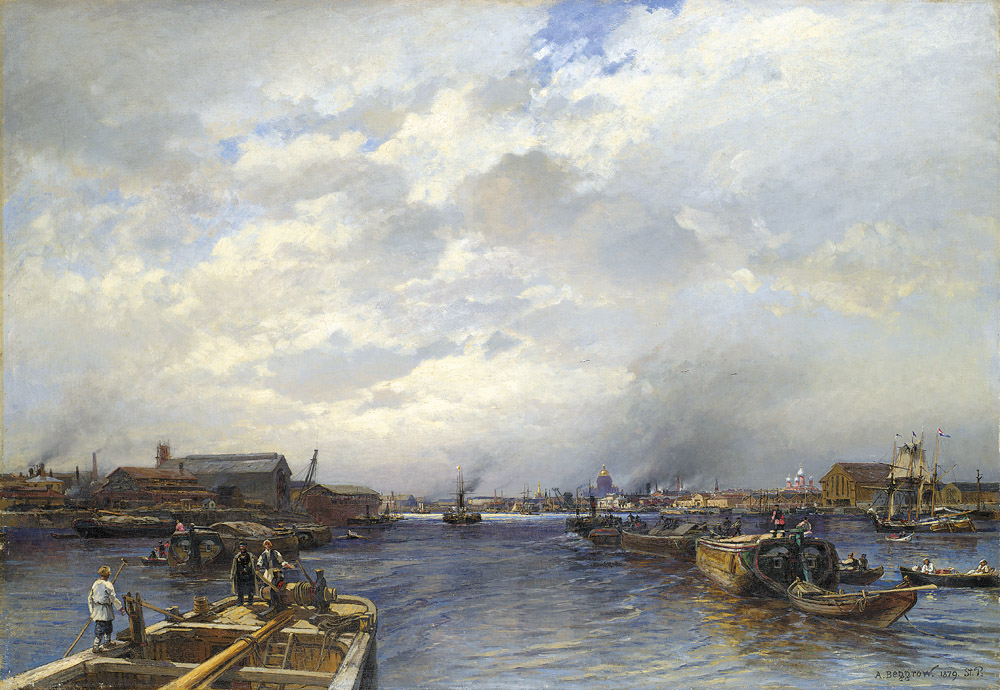MacDougall Auctions 28 November 2008
28 November 2008

17. BEGROV, ALEXANDER 1841-1914
Approach to St. Petersburg on the Neva signed, dated 1879 and inscribed "St. P.", also further inscribed and numbered "A.D.M. 26911" and "N235" on the labels on the frame
Oil on canvas, 90 by 131 cm.
400,000-600,000
Provenance: Former collection of the Emperor Alexander III, Anichkovskiy Palace, No. 235.
Private collection, Latin America.
Authenticity has been confirmed by Vladimir Petrov.
Exhibited:VII Exhibition of Itinerants, St. Petersburg-Moscow-Odessa-Kiev, 1879-1880
Literature: Exhibition catalogue, VII Exhibition of Itinerants, St. Petersburg-Moscow-Odessa-Kiev, 1879-1880.
G. Romanov, Encyclopaedia of the Itinerants' Exhibitions 1871-1923, St. Petersburg, 2003, p. 37, plate 5-12 illustrated.
Alexander Begrov was one of the most renowned Russian marine
artists of the second half of the 19th century. The banks of
the Neva occupied a special, and predominant place in his
works. He first discovered the banks as a subject for his work
when he was already a mature, independent master. One of his
favourite views overlooked the left banks of the Neva, from the
Kozhevennaya line of Vasilievsky island, with the domes of
Saint Isaac’s cathedral and of the church of St. Catherine. It
was here that he began his series of St. Petersburg landscapes in
1876, and here also where he later returned to paint, constantly
changing his angle as well as the ships in the foreground.
Begrov inherited his father’s artistic talent, but enrolled as a
naval officer. He was educated at the Naval Ministry
Engineering and Artillery College. It was the unveiling of a
monument to Emperor Nicholas I at the College in 1859 that
proved pivotal for his future artistic career. Begrov painted the
scene, and the war department was so taken by his talent that it
commissioned Begrov to tour the world as both a naval officer
and an artist. Moving from the frigate Oslabya to the Aleksandr
Nevsky his voyage ended tragically when the frigate sank near the
coast of Denmark. Together with the surviving crew, Begrov
met the famous marine artist, Bogoliubov, who had been commissioned
to create two works portraying the destruction of the
Aleksandr Nevsky. Bogoliubov needed to use Begrov’s sketches
and drawings in order to complete his works. Their acquaintance
helped Begrov enter the class of Professor M. Klodt at the
Academy of Arts.
In 1874 Begrov was sent to Paris, where he perfected his skills under
the guidance of the famous artist Bonnard as well as his former
mentor Bogoliubov. However, the death of his father forced
Begrov to return to Russia, where he devoted himself entirely to
his painting. He also started an association with the Society of
Itinerants, becoming a member in 1876.
Begrov’s 1879 work Approaching to St. Petersburg on the Neva, is considered
among his best works on this theme, capturing the classical
view of St. Petersburg from the mouth of the Greater
Neva. Travelling the country with the seventh Wandering
Exhibition, the work was exhibited alongside another one of the
artist’s masterpieces The Banks of the Neva from 1876 (currently
in the State Russian Museum). Both depict the same view of St.
Isaac’s Cathedral to the Church of St. Catherine. However, the
sea in the foreground, which in essence is the subject of each
work, is remarkably different. In the three years separating the
two works, Begrov’s composition took on a somewhat more dynamic
form. The quiet day to day life around the river with its
classical image of the city and its natural elements, had moved
into the industrial age with its creative and technical achievements
and the sea fleet and industrial architecture. This clash
between old and new became of utmost importance to the
artist’s work. From this, the romantic atmosphere of the city
emerges from the carefully recorded details of this new age.
Begrov viewed the river Neva as the heart of St. Petersburg, but
he always made ensured the vision of the city’s founder, Peter
the Great, was conveyed effectively.
Today, little remains of the artist’s favourite view taken from the
Kozhevennaya line of Vasilievsky island. On the left hand side
of the work, one can observe the industrial structures of
Vasilievsky island. On the opposite bank, are the Admiralty
wharfs, which was once the site of the Berda factory. The view
is framed by St. Isaac’s Cathedral and the Church of St.
Catherine, built by the architect Ton, but demolished in 1929.
Both structures were built during the time of Tsar Nicholas.
Begrov’s contemporaries noted that as a naval officer, he knew all
there was to know about the construction of a ship. “The masts,
shipyards, sails, and every other detail were everyday items to
him. He would criticise any work depicting sailing vessels which
contained the smallest inaccuracy, growling “Look at that! See
how that sail has been raised? How will the ship be able to sail
like that, tell me that! What nonsense!”. However, such attention
to detail in no way compromised his achievements and his style
remained on par with that of his western contemporaries.
Notes on symbols:
* Indicates 5% Import Duty Charge applies.
Ω Indicates 20% Import Duty Charge applies.
§ Indicates Artist's Resale Right applies.
† Indicates Standard VAT scheme applies, and the rate of 20% VAT will be charged on both hammer price and premium.